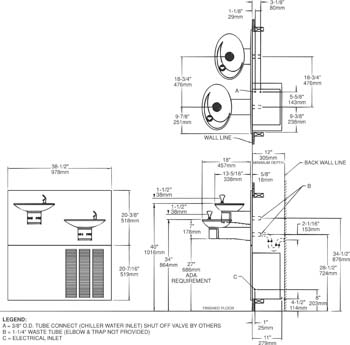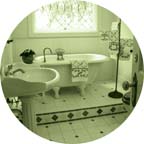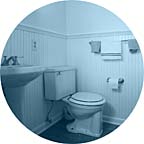Editor's Note: "Back to Basics"

Product Knowledge
While the architect may be concerned about the material, color and size of a fixture and the style and finish of the accessories, he will generally leave the selection process to the engineer, especially when the project is more functional than aesthetic. The general selection of what fixtures are provided is usually done by the architect, but the engineer is normally asked to do the specifying. To be effective, an engineer must develop a good background of product knowledge.The knowledge of fixtures gathered from experience, trade publications, trade shows and manufacturer representatives is one of the greatest strengths a plumbing engineer has to offer. A complete fixture specification will include the material, finish, color, accessories or trim and supports. While these categories apply to all fixtures, quality and cost, in turn, affect each item. Understanding the construction, operation, practicality or application, reliability, cost and reputation of each item are all important aspects of the engineers' product knowledge.
Material
The most basic concern is the fixture and trim material. The material of construction, color and finish has a tremendous impact on cost. A simple fact is that white vitreous china fixtures are typically less expensive than any other color.Terrazzo, enamel cast iron, vitreous china, stainless steel and even some of the newer plastic and composite materials are all options that the engineer has to choose from. Not all materials are used for all products. Each material has its own unique properties that determine a fixture's finish in both color and texture. Fixtures have been produced in vitreous china, enameled cast iron, stainless steel, fiberglass, plastic, glass, and even wood. Accessories have been produced from brass, plastic, copper, bronze and stainless steel. New plastic composite materials have emerged and are competing against the classic materials in cost, quality and durability. The plumbing engineer must understand all of this information in either choosing a fixture or advising others as to the advantage and disadvantage of each material.
Fixture Type
The type or style of fixture is as important as the material selection for aesthetic and functional reasons. Size, shape, mounting considerations and cost are all part of this decision. Water closets can be flush valve operated, pressure assist, or flush tank type. Flush valves are typically preferred for commercial installations, while flush tanks and pressure assist are predominantly used in residential or light commercial construction. The choice affects the flow rate, size and pressure of the water supply required. Floor or wall mounting, elongated vs. rounded front, top or back spud, siphon jet vs. blow out are additional choices that must be made. For lavatories, the choices relate to size, shape depth, and location of overflow, rim configuration, mounting, and type of support, among others. Bathtubs come in many sizes and shapes, as do shower receptors. It is important to know what the standards are and what might be unconventional and consequently more expensive. Awareness of the different fixture choices, as well as the installation parameters associated with each allows the engineer to offer options to the architect and end user that they otherwise might not know exist.Accessories and Trim
A fixture does not stand alone. It can have several accessories that are commonly referred to as trim. The trim is also required for the fixture to operate. Faucets, flush valves, traps, supply stops, shower valves and shower heads are all examples. Trim has two main aspects to consider besides the aesthetics, the function and operation of each item.
Faucets
A faucet's function is to deliver water, but the engineer is mostly concerned with its operation. Faucet spouts come in many shapes and styles, and can be either fixed or have the ability to swing. The faucet handles can be separated for the hot and cold water, combined into a single-handled model or can be absent altogether in a hands-free electronic model. Faucets can also be spring-operated to close automatically. These parts of a faucet are apparent to the architect and users making this step in the selection straightforward.What the plumbing engineer brings to the table is knowledge of how each of these choices functions and the implications they will have on the installation. If a faucet is manual, the engineer must be familiar with the type of cartridge the faucet uses and its service life. The same is true for spring-operated self-closing faucets. The electronic faucet has a sensor that initiates operation and can be powered by either batteries or hard wired and may require a transformer to step down the necessary voltage. The engineer should become familiar with each manufacturer's sensors operation and their quirks. The sensor type determines how many cycles of operation there are before the batteries will need replacement. The electronics that are in the marketplace currently are dependable and replace less reliable earlier models. For faucets that are electronically operated, temperature control is usually an option that must be chosen. Flow rates are variable on faucets, depending on aerator or flow control devices. Frequency of operation, cost and sanitation requirements are the factors in making the final decision.
Flush Valves
Flush valves deliver water to commercial fixtures such as water closets, urinals and clinical sinks. They can be manually operated or are electronically activated using sensor technology similar to that used in faucets. The main component used to control the operation of a flush valve is either a diaphragm or piston. The engineer will need to know how effective each valve is and how it is affected by water quality before it needs to be serviced. Flush valves are typically exposed, but are available in other options such as: back spud, partially concealed or fully concealed. The choice of flush valve type and installation is typically important to the owner for security or other reasons. The plumbing engineer should know and coordinate the access and installation requirements for each. Some concealed flush valve water closets require that there be access to the fixture from the chase side for installation, which can be disastrous if overlooked.Shower Valves and Heads
The engineer is typically concerned with the valve and head. Most shower heads are fixed. ADA showers require a handheld shower head on a slide bar in the shower compartment. Sometimes the shower's use will limit the selection of a shower head. For example, a vandal-resistant shower head is the appropriate model for a school or public pool. Most shower head decisions are driven by flow requirements and aesthetics, which directly relate to cost. The choice of one shower head over another will rarely affect any system design considerations.The choice of a shower valve is more important to the engineer than the shower head. Individual shower valves are used in residential buildings, hotels, hospitals and health club locker rooms. Institutional settings with multiple showers in a single room will have a centralized valve. The shower valve must either be pressure balanced or thermostatic mixing for safety reasons and to comply with the plumbing codes. Each valve has its unique operating method and infrastructure requirements of which the engineer needs to be familiar. An inexpensive shower valve may not provide the flow desired by the user due to excessive pressure drop. Shower/tub combinations should always be selected based on a shower valve that can effectively fill the tub in addition to providing a decent shower. Thermostatic shower valves are more accurate at controlling temperature fluctuations, but they are also more expensive than pressure balanced valves.
Water Supply Valves, Stops
Another item that is not given much thought is the water supply valves, commonly referred to as stops. They are essentially miniature valves sized for either a 1/2- or 3/8-inch water connection." Tank type water closets, water coolers and faucets rely on stops to shut off the water for servicing of individual fixtures. Stops use washers and packing. In newer models, miniature ball valves are used for their operation. Being familiar with the costs, benefits and drawbacks of each of the styles is important. A poor quality stop will either leak and need replacement, or seize up and not be able to function. It is important that a high quality stop be specified because they frequently sit unused for extended periods of time before being called into service when the fixture is in need of repair.
Toilet Seats
Every piece of trim will need to be looked at for its construction and longevity. Even a simple toilet seat has its subtleties. The hinge should be of good quality, constructed of stainless steel and be self-sustaining. Public-use water closets require an open front seat. A microbial finish can be selected for additional sanitation. The shape of the seat can be flat or have a contour for comfort. Each piece of trim has selections that need to be made in style, material, finishes and cost.Carriers and Supports
All wall-mounted fixtures require either a carrier or some type of mounting bracket. Carriers are constructed of cast-iron and steel, and primarily support both the fixture and forces the users will apply to the fixture. Mounting brackets are typically steel plates mounted to the wall's structure. Adequate space for the carrier must be provided in the wall. There are several manufacturers that carry a complete line of carriers for the entire spectrum of fixtures available. Carriers are typically used for water closets, urinals, lavatories, scrub sinks and water coolers.Water closet carriers are the only carriers that provide a direct connection to the building's plumbing system, as well as the only carriers that need to support the weight of the user. Because of their connection to the plumbing system, consideration must be given to the direction of the outlet on the carrier (left, right, vertical, hub, no hub, etc.).
All other carriers support the fixture but do not provide a direct connection to the plumbing system and may be nothing more than just a mounting plate fastened to the wall. The selection of the supports and carriers is often overlooked, hence, carriers need to be included in the specifications.
Coordination With Other Trades
Faucets, flush valves, electric water coolers and even soap dispensers can rely on power either from the building or batteries. The building type, owner preference and application will help decide the power source. When the power source is from the building the electrical engineer must be informed of the power loads and locations. A transformer may be required to step down the voltage for the operation of electronic flush valves and faucets. This transformer can be specified with the fixture or by the electrical engineer, but is typically not provided as standard equipment. A scrub sink or a washfountain are examples of fixtures that are hard wired and whose electrical connections are often missed.On an architectural plan, the fixtures are only representational and could very possibly not be accurately sized. The engineer should make sure there is adequate space for all of the plumbing fixtures in their intended locations. Verification must be done to ensure that the selected sinks will fit into the casework, and that adequate space has been allocated for fixture carriers. The space required for the compressor of a recessed electric water cooler can be substantial, and when placed within the wall should have some provision for heat rejection (see illustration on page 46). The best tool to assist the coordination effort is to provide the architect with a fixture cut book.
Formalized Fixture Selection
An engineer will go through the drawing space by space to formalize the fixture selection process by identifying each different fixture type with a tag. It begins with a list of each room and the fixtures it contains. They are then listed on the drawing fixture schedule. A package of cut sheets of each complete fixture, including its trim, supports and any special requirements is created. Once a packet of fixture cut sheets is assembled, the engineer should send the architect/owner a copy and put the original in the project file. The fixture booklet provides visual confirmation of what is proposed for the architect/owner and others (such as a user group), who may not be familiar with the verbal description and model number of the fixture selected. The booklet is created by making copies of catalog cut sheets or downloading a cut sheet from a manufacturer Web site. The advantage of fixture cut sheets on the Web is the ability to easily transmit them via email. If the engineer wanted to review a fixture with an architect, the engineer can send him/her a link to the Web site or forward a product cut sheet easily. The booklet is also helpful as a visual review if an alternate manufacturer is submitted and needs to be compared to the original specified model. A drawing review and selection of fixtures followed up with a clear communication of the selection to the architect can greatly help a project progress smoothly.Proper selection of plumbing fixtures is a very significant aspect of the project for the plumbing engineer to control. The proper evaluation of the building will steer the fixture decision. Proceeding with the selection using a step-by-step process will help insure that both the proper fixtures are selected with the accompanying accessories. Coordinating the selections with the architect and electrical engineers will also ensure the fixtures will have proper power and spacing. Once the general fixtures have been chosen, the engineer will use his/her knowledge and experience to finish the fixture selection by deciding on the appropriate accessories, trim and supports. To assist in this coordination process, the engineer should compile a fixture cut booklet to present the fixtures selected and all their requirements for the project and communicate this information to all the involved parties.
Standardizing the process of fixture selection and specifications will ensure that no part of the selection is missed. Each part of the selection process is important and will assist in preventing costly change orders when fixtures arrive on the site that are either incorrect, incomplete or undesired.